As a Suzuki motorcycle owner, you know that keeping your bike in top shape is essential for both performance and safety. Regular oil changes, tire pressure checks, and brake inspections are just the beginning. You'll want to pay close attention to the chain and battery, along with other key components that can make a significant difference in your ride. Curious about the specific maintenance tasks that can extend your bike's life and enhance your riding experience? Let's explore these essential tips together.
Quick Takeaways
- Regularly change oil every 3,000 to 5,000 miles to ensure optimal engine lubrication and performance.
- Maintain proper tire pressure and inspect tread depth monthly for safety and stability.
- Check brake fluid levels and inspect pads and rotors to ensure effective braking performance.
- Inspect and clean the chain regularly, ensuring proper tension and lubrication to enhance performance.
Regular Oil Changes
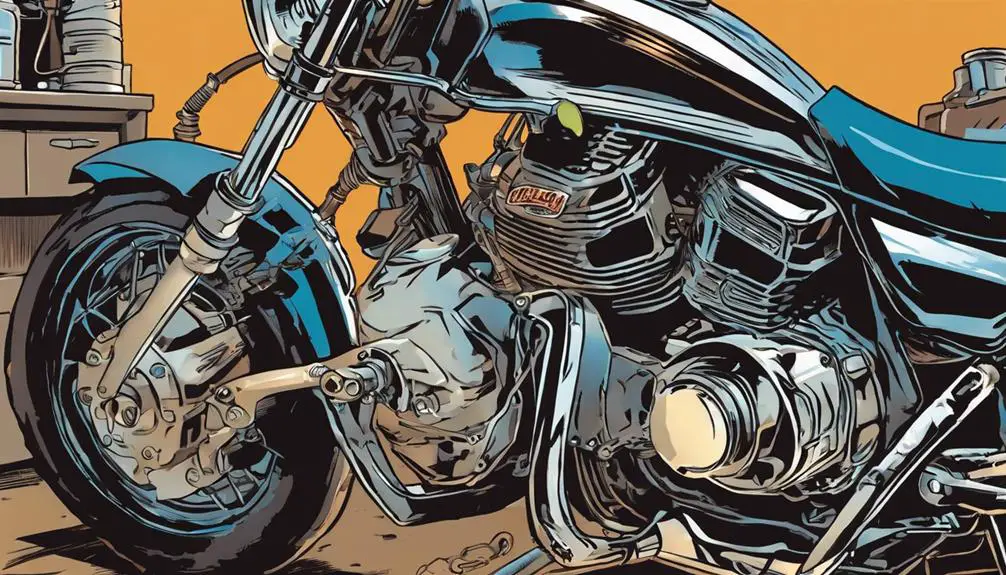
Changing your oil regularly is essential for keeping your Suzuki motorcycle running smoothly and efficiently. When you ride with freedom, you want your machine to respond perfectly, and fresh oil is key. It lubricates the engine, reduces friction, and helps prevent wear and tear. If you neglect this vital task, you risk damaging your bike and losing that exhilarating ride.
You should aim to change your oil every 3,000 to 5,000 miles, but always check your owner's manual for specific recommendations.
When it's time, gather your supplies: the right oil, a new oil filter, and tools. Start by warming up your engine to thin the oil, making it easier to drain. Next, remove the drain plug and let the old oil flow out completely.
Replace the filter, then add the new oil—don't forget to check the level!
Tire Maintenance
Keeping your tires in top shape is essential for a smooth ride.
You should check tire pressure regularly, inspect tread depth frequently, and rotate your tires as needed.
These simple steps can make a big difference in your motorcycle's performance and safety.
Check Tire Pressure Regularly
Regularly checking your tire pressure guarantees peak performance and safety while riding your Suzuki motorcycle. When you hit the open road, the last thing you want is to worry about under-inflated tires. Low pressure can lead to poor handling, increased wear, and even dangerous blowouts. By keeping your tires at the recommended PSI, you enhance your riding experience, allowing for better grip and stability.
Make it a habit to check your tire pressure at least once a month or before any long ride. It's simple—just grab a reliable pressure gauge and check both the front and rear tires when they're cold. If they're low, fill them to the recommended pressure listed in your owner's manual or on the tire itself.
Don't forget to take into account the weather; temperature changes can affect tire pressure. If you're riding in extreme heat or cold, check your tires more frequently.
Ultimately, keeping your tire pressure in check not only boosts your motorcycle's performance but also gives you the freedom to ride with confidence. So, take a moment before your next adventure to verify your tires are ready to roll!
Inspect Tread Depth Frequently
Inspecting your motorcycle's tire tread depth guarantees ideal grip and safety on the road. It's not just about looking cool; it's about feeling confident and free as you navigate through twists and turns. Tread depth plays an essential role in how your tires perform, especially in wet or slippery conditions. To assure your safety and enhance your riding experience, check your tire tread depth regularly.
Here are some key points to remember:
- Use a tread depth gauge or the penny test to measure accurately.
- Look for wear indicators on your tires; they signal when it's time for a change.
- Check for uneven wear patterns that may indicate alignment issues.
- Inspect both the front and rear tires; they wear differently.
Rotate Tires as Needed
Rotating your tires periodically helps guarantee even wear and extends their lifespan, enhancing your motorcycle's performance on the road. It may seem like a small detail, but keeping your tires in check can make all the difference in your ride. When you regularly switch the front and rear tires, you promote balanced wear, ensuring that you maintain ideal grip and control.
Make it a habit to check your tire rotation every 4,000 to 6,000 miles, or as recommended in your Suzuki owner's manual. This isn't just about extending the tires' life; it's about liberating your ride from the risk of handling issues and blowouts. You want to feel one with the road, not fight against it due to uneven tires.
When rotating, inspect the tires for signs of damage or wear. Swap them side-to-side or front-to-back, depending on the tread pattern and type of tires you have.
Don't forget to check the air pressure, too. Properly inflated tires make for a smoother, safer ride, empowering you to embrace the open road with confidence.
Brake System Checks
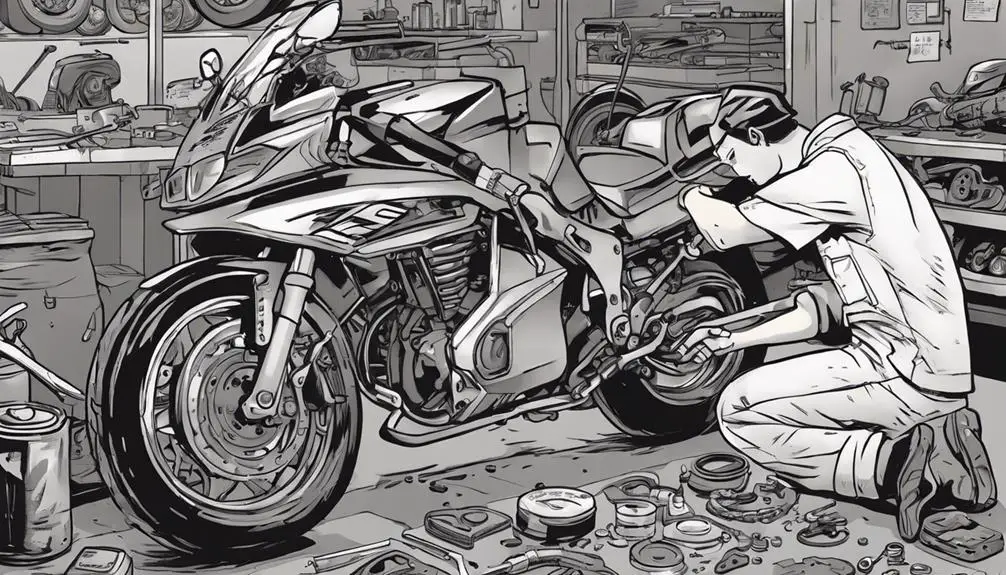
Check your motorcycle's brake fluid level and look for any signs of leaks to confirm your safety on the road. A well-functioning brake system is essential for your freedom on two wheels. Inspecting your brake system regularly helps guarantee you're always in control.
Here are some key checks you should perform:
- Brake Fluid Level: Make certain it's at the recommended level; low fluid can compromise braking power.
- Brake Pads: Examine them for wear. If they're too thin, replace them to avoid damage to the rotors.
- Brake Lines: Look for cracks or bulges. Damaged lines can lead to brake failure.
- Disc Rotors: Check for scoring or warping that could affect braking efficiency.
Chain and Sprocket Care
How often do you pay attention to your motorcycle's chain and sprockets, as they play an integral role in your bike's overall performance? If you want to feel the freedom of the open road, keeping these components in top shape is vital.
Start by checking your chain tension regularly; it shouldn't be too loose or too tight. A well-adjusted chain guarantees smooth power transfer, letting you release your spirit on every ride.
Next, don't forget to clean your chain. Dirt and grime can wear it down, so use a good chain cleaner and a brush to scrub away the muck. After cleaning, apply quality chain lubricant to reduce friction and extend its life. Remember, a well-lubricated chain not only enhances performance but also minimizes noise—perfect for those moments when you crave the quiet of the ride.
Lastly, inspect your sprockets for wear. If you notice any hooked or broken teeth, it's time for a replacement. Keeping your chain and sprockets in check allows you to enjoy your Suzuki motorcycle to the fullest, paving the way for adventures and liberation on two wheels.
Battery Maintenance
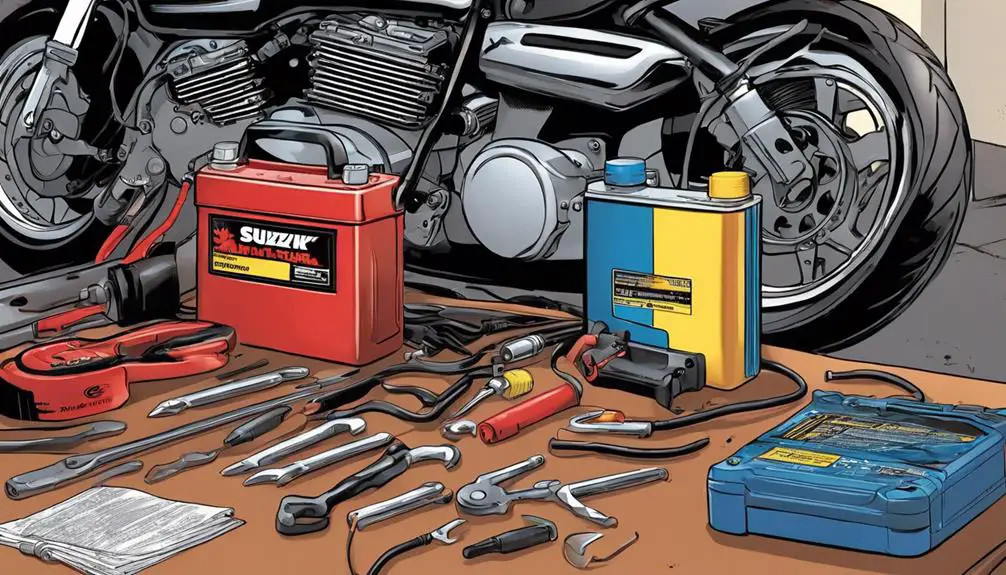
To guarantee your Suzuki motorcycle starts reliably every time, regular battery maintenance is essential. A well-cared-for battery not only extends its life but also guarantees you're free to hit the open road without worry.
Here are some key steps to keep your battery in top shape:
- Inspect Connections: Regularly check the battery terminals for corrosion and guarantee they're tight.
- Clean the Battery: Use a mixture of baking soda and water to clean corrosion off the terminals.
- Check Fluid Levels: If your battery isn't maintenance-free, guarantee the electrolyte levels are adequate. Top off with distilled water as needed.
- Test Voltage: Use a multimeter to check the voltage regularly. A healthy battery should read around 12.6 volts.
Air Filter Inspection
Your Suzuki motorcycle's performance heavily relies on a clean air filter, so regular inspections are essential. An air filter clogged with dirt and debris restricts airflow, which can lead to reduced power and efficiency. To keep your ride smooth and liberating, start by checking your air filter every few months or before long trips.
Removing the air filter is usually straightforward. Locate it, typically near the engine, and carefully detach it. Inspect for any signs of grime or damage. If it looks dirty, it's time to clean or replace it.
For reusable filters, a gentle wash with soap and water can do wonders. Avoid harsh chemicals that could damage it. Once it's clean and dry, make sure it's securely reinstalled.
Electrical System Monitoring
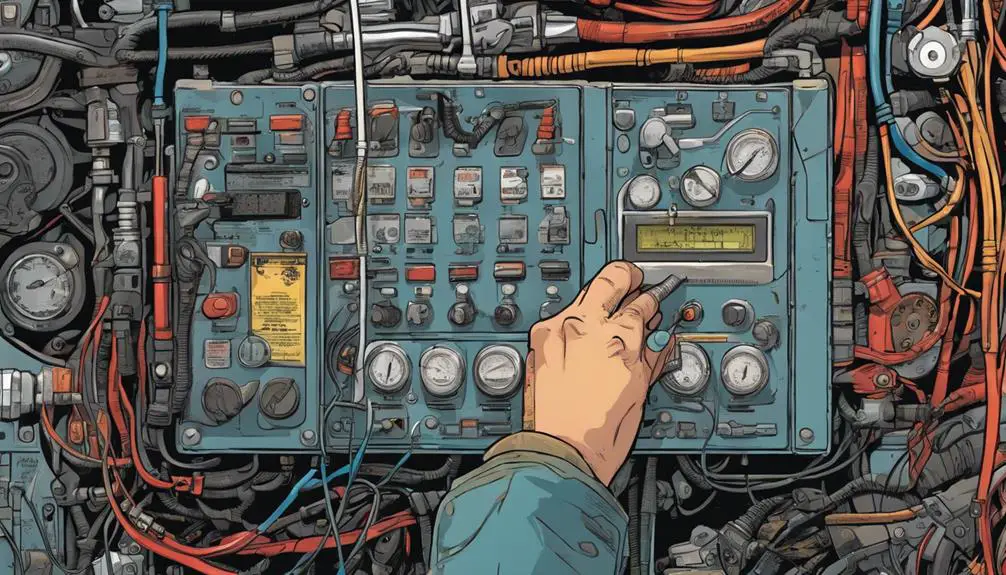
Keeping your Suzuki's electrical system in top shape is essential for a smooth ride.
You need to check battery care essentials and inspect wiring regularly to avoid potential issues.
Let's get into the key steps you should follow for proper electrical system monitoring.
Battery Care Essentials
Regularly monitoring your Suzuki motorcycle's battery helps guarantee peak performance and longevity. A well-maintained battery is essential for a smooth ride and reliable starting.
Here are some key practices to keep your battery in top shape:
- Check the charge level: Use a multimeter to measure voltage; it should be around 12.6 volts or higher when fully charged.
- Inspect for corrosion: Look for any buildup on the terminals and clean it with a mixture of baking soda and water.
- Ensure secure connections: Loose terminals can cause intermittent issues. Tighten them gently but firmly.
- Maintain electrolyte levels: If you have a conventional battery, check the fluid levels regularly and top up with distilled water if needed.
Wiring Inspection Tips
Routine wiring inspections are vital for guaranteeing the electrical system of your Suzuki motorcycle operates smoothly and safely. Start by checking the wiring harness for any frayed or damaged wires. Look for signs of wear and tear, like cracks or exposed metal. If you spot any issues, it's essential to address them immediately to avoid bigger problems down the road.
Next, inspect the connectors. Confirm they're secure and free from corrosion. A loose connection can lead to electrical failures, so don't overlook this step. If you find corrosion, clean it with a contact cleaner designed for electrical components.
Don't forget to examine the ground connections. A poor ground can cause erratic behavior in your bike's electrical system. Verify all ground points are tight and free from rust.
Lastly, consider the routing of your wires. They should be away from hot surfaces and moving parts. Properly routing the wiring helps prevent damage and guarantees longevity.
Coolant Level Management
Check your coolant level frequently to guarantee your Suzuki motorcycle runs smoothly and prevents overheating. Maintaining the right coolant level is essential for ideal engine performance, allowing you to enjoy the open road without worries. A well-managed coolant system protects your engine from excessive heat, ensuring it performs at its best.
Here are some quick tips to help you manage your coolant level effectively:
- Inspect regularly: Check your coolant level at least once a month or before long rides.
- Use the right coolant: Always use the coolant specified in your owner's manual to avoid potential issues.
- Look for leaks: Examine hoses and connections for any signs of leaks or wear.
- Monitor temperature: Keep an eye on your motorcycle's temperature gauge; it can signal when coolant levels are low.
Cleaning and Detailing
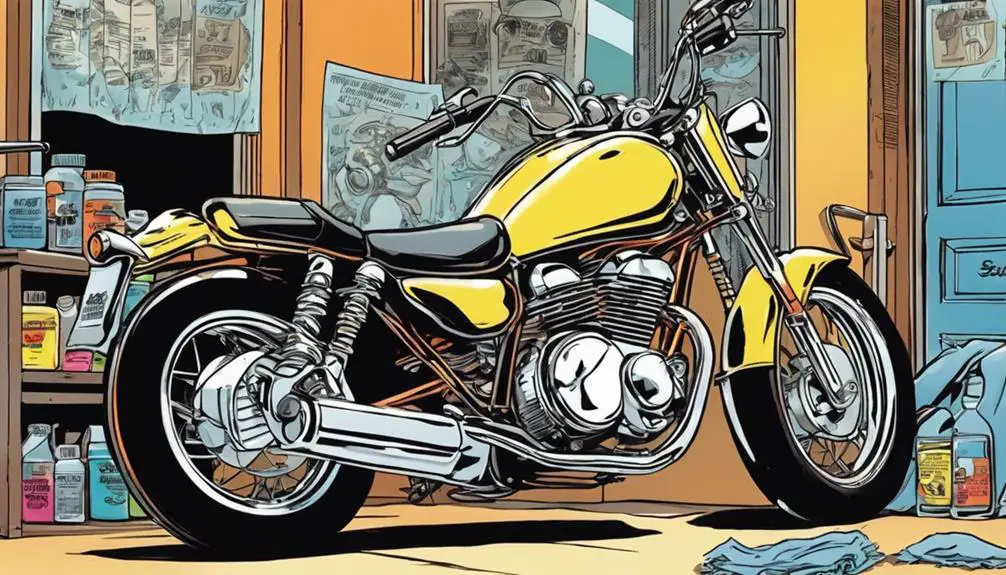
Keeping your Suzuki motorcycle clean and well-detailed not only enhances its appearance but also helps maintain its performance and longevity. You want your ride to reflect your spirit, and a clean bike is a happy bike.
Start by washing it regularly with a gentle soap specifically designed for motorcycles. Avoid harsh chemicals that might damage the paint or finish. Use a soft sponge or microfiber cloth to gently scrub away dirt and grime, paying special attention to the wheels and chain. Rinse thoroughly to remove all soap residue and dry your bike with a clean towel to prevent water spots.
Next, don't forget to detail the chrome and metal parts. A quality metal polish can bring back that shine and protect against corrosion.
Apply a wax or sealant to the painted surfaces for extra protection against the elements.
Common Questions
How Often Should I Check My Motorcycle's Coolant Level?
You should check your motorcycle's coolant level regularly, ideally every couple of weeks or before long rides.
Keeping an eye on it helps you avoid overheating and guarantees your bike runs smoothly.
If you notice it's low, top it up with the correct coolant type.
What Type of Oil Is Best for My Suzuki Motorcycle?
Choosing the right oil for your Suzuki motorcycle is like finding the perfect key for a locked treasure chest. You want something that'll release the engine's potential.
Generally, synthetic oils are your best bet; they offer superior protection and performance. Check your owner's manual for specific viscosity recommendations, but remember: high-quality oil guarantees your ride stays smooth and powerful, giving you the freedom to conquer the open road without worry.
How Do I Know When to Replace My Brake Pads?
You can tell it's time to replace your brake pads when you hear a squeaking or grinding noise while braking.
If your bike pulls to one side, that's another sign.
Check the thickness of the pads; if they're less than a quarter inch, it's time for a change.
Don't ignore the warning lights on your dashboard either.
Staying vigilant about your brakes keeps you safe and free on the open road.
Can I Use Car Oil in My Motorcycle?
You've probably wondered if you can just grab that car oil sitting in your garage for your motorcycle. It's tempting, right?
But don't do it! Car oil isn't designed for the higher temperatures and specific friction needs of a motorcycle engine.
Using it can lead to poor performance and even damage.
Stick with motorcycle oil to keep your ride smooth and reliable.
Your bike deserves the best, and so do you!
What Tools Do I Need for Basic Motorcycle Maintenance?
For basic motorcycle maintenance, you'll need a few essential tools.
Grab a set of wrenches and sockets to tackle bolts and nuts.
A screwdriver set helps with various screws, while pliers can assist in gripping and twisting.
Don't forget a torque wrench for precision and a tire pressure gauge to guarantee your ride's safety.
Having these tools on hand empowers you to keep your motorcycle in top shape, giving you the freedom to ride confidently.
Wrapping Up
In the world of motorcycle riding, neglecting maintenance can lead to costly repairs and unsafe rides, while regular upkeep guarantees smooth performance and peace of mind.
By balancing routine tasks like oil changes with vigilant checks on your brakes and tires, you protect both your investment and your safety.
So, embrace the commitment to maintain your Suzuki.
After all, a well-cared-for bike isn't just a machine; it's your ticket to adventure and freedom on the open road.